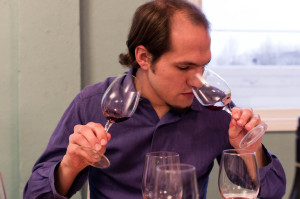Hello readers! I am currently on my maternity leave spending some quality time (and little sleep) with my brand new son! Enjoy this guest post from today’s featured author!
About Deborah: For the last ten years Deborah Parker Wong, DWSET has taught, judged, written and spoken about wine. She is Northern California Editor for three publications – SOMM Journal, The Tasting Panel and the new quarterly Clever Root – and contributes features on production technology to Vineyard & Winery Management Magazine. As lead instructor for Discover Wine & Spirits Academy, she teaches Wine & Spirits Education Trust certifications and, as an adjunct professor at Cabrillo College, her class on wine faults inspired this column.
This column is reproduced with permission. For more on SOMM Journal and how to subscribe to their publication, please visit their website here.
Of all the ways that winemaking can go sideways, when it comes to noticeable flaws or faults that can make a wine undrinkable prevention is the name of the game. Winemakers are trained to recognize and address problems with wine quality early in the vinification cycle lest they find themselves coping with the consequences. For the rest of the industry, being able to readily identify the litany of defects that can afflict wine requires sensory training and a baseline understanding of molecular biology and chemistry. This is not everyone’s cup of tea.

Photo by Flickr user Luke Gray
But, if you’re fascinated by assessing wine quality as are most professional wine judges (and those trained to assess beer, cider, olive oil etc.) recognizing and identifying flaws and faults in wine is comparable to bird watching. You’ll encounter garden-variety species like Brettanomyces and TCA often enough but it’s the rare sighting and identification of an elusive species like the stubborn defect of dimethyl disulfide that keeps birdwatchers and, in this case, wine judges hooked.
Thanks to modern winemaking practices the vast majority of commercially-made wine is flawless if not exemplary. But when compared to other types of beverages and even other beverage alcohols, historically wine has had a higher failure rate. Consider the time-honored practice of nosing and tasting a wine one that’s attributed to appreciation but serves a more practical purpose of gauging its condition before committing to a full pour.
The Physiology of Flavor
To begin even a cursory study of wine quality, it’s essential that we understand our own physiology and the types of sensory information that we’re processing. We also need an analytical method for recording our observations and perceptions. With as much as 80% of our perception of flavor attributed to aroma or smell, the olfactory system is doing most of the heavy lifting when we’re evaluating wine.
Professional tasters including winemakers and trained wine judges can reliably evaluate dozens of wines and, in some cases, may taste in excess of 150 wines that are in various stages of fermentation or development on any given day. Evaluating that number of wines takes practice and the skill could be considered the “Olympic weight lifting” of wine tasting. It’s entirely possible because we can quickly refresh our sense of smell—raising your heart rate is one way—and because olfactory receptor cells have the ability to regenerate.
There aren’t many specialized cells in the human anatomy that can regenerate and that includes our taste receptors. The number of taste buds we’re born with varies by individual and, on average, we lose half of our taste receptors by the time we’re 20 years old. When we’re smelling and tasting wine we’re using our chemosensory senses and both the olfactory and gustatory sensory systems work in tandem. Aroma and flavor molecules undergo an exchange known as transduction by which they become electromagnetic signals that travel to the olfactory and gustatory cortexes for processing by higher areas of the brain.
But aroma and taste aren’t the only components of flavor. There’s temperature and texture to account for as well. Both are sensed by the Trigeminal nerve which also enervates the taste buds and sends signals to be processed in the Somatosensory Cortex. All three sensory systems— the olfactory, gustatory and trigeminal— operate within the Limbic System and process sensory information to complete the perception of flavor.Mastering Aroma Molecules
However resilient, your sense of smell can still fatigue and you experience this when your olfactory receptor cells are filled up with aroma molecules. Of the several hundred volatile aroma compounds found in wine, cork taint caused by 2,4, 6-trichloroanisole (TCA) is a particularly fatiguing as it distorts the perception of smell. The molecule partially blocks olfactory signal transduction allowing only a few aroma molecules to pass through the cell wall as electrochemical signals.
That’s why the fruit and positive aromas of corked wines are suppressed. We’re not smelling the TCA, it’s blocking us from smelling the wine’s dominant aromas. What we do smell are the truly unpleasant aromas that are found in all wines but are normally masked by aroma molecules that are easier to detect. Whether it’s perceived as a flaw or fault, TCA has one of the lowest detection thresholds of all the off-putting molecules that taint wine.
Our ability to detect odors is one of our superhuman powers. Odors are created by a family of molecules some of which are more dominant and, as such, are easier to detect.

Photo courtesy Flickr user chispita_666
Vanilla, for example, is a common aroma and flavor in wine that’s composed of 170 different volatile aroma compounds with vanillin being the most dominant. Vanilla is one of the few low threshold aromas that can be enjoyed at a very high concentration without losing its appeal. These unique characteristics are what make it such a popular aroma and flavor.
Until recently scientists thought that humans could only detect about 10,000 odors but new research has demonstrated that the number is far greater. The average person can detect upwards of one trillion odors but even the most highly-trained sensory expert can only identify a few thousand. Detecting off odors is just the beginning. To reliably identify flaws and faults in wine, we’re sifting through a family of volatile molecules dominated by one that smells the strongest. A taster has to be able to recognize and identify the dominant molecules responsible for the defect. The recognition threshold is the lowest concentration of an odor that can be identified by a taster. When 50% of tasters can identify an odor, it’s said to be at the perception threshold.
Most of the compounds with low odor thresholds that are found in wine including pyrazines, thiols and various mercaptans are pungent and negative at high concentrations. They’re among the many culprits that detract from wine quality. Said one wine writer when confronted with an unrecognizable fault, “The biggest problem with wine faults is that there are so many.”
One of the easiest way to get up to speed in identifying garden-variety and less common wine faults is to spend a day judging a home winemaking competition. All you need is a basic understanding of what can go wrong in the vineyard, tank, barrel or bottle to result in a wine that’s out of condition and to recommend the most likely remedies. Typically your tasting notes will be anonymously returned to the winemakers and you’ll be indirectly improving wine quality while you master the offending molecules.
Author’s note: This series originated from curriculum developed for a semester-long wine faults class offered by the Culinary Arts and Hospitality Management Department at Cabrillo College in Aptos, Calif. My gratitude to Department Chair Sue Slater, CSW, FWS for her support and guidance.

![Photo courtesy Henry Vandyke Carter [Public domain], via Wikimedia Commons](http://www.academicwino.com/wp-content/uploads/2016/01/trigeminal-nerve-the-academic-wino-300x212.png)